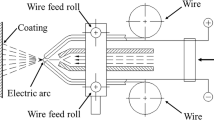Abstract.
In three different examples, the effects of the oxidation behaviour as well as the microstructural stability of high temperature materials and protective coatings was determined by combining the results of kinetic studies with extensive analytical investigations using, among other techniques, SNMS, SIMS, SEM, TEM, Rutherford back scattering (RBS) as well as X-ray diffraction.
1) The effect of water vapour on the oxidation behaviour of 9% Cr steels in simulated combustion gases has been determined. The effects of O2 and H2O content on the oxidation behaviour of 9% Cr steel in the temperature range 600–800 °C showed that in dry oxygen a protective scale was formed with an oxidation rate controlled by diffusion in the protective scale. In the presence of water vapour, after an incubation period, the scales became non-protective as a result of a change in the oxidation limiting process. The destruction of the protective scale by water vapour does not only depend on H2O content but also on the H2O/O2-ratio.
2) The increase of component surface temperature in modern gas turbines leads to an enhanced oxidation attack of the blade coating. Improvements in corrosion resistance and longer lifetime thermal barrier coatings in gas turbines have been achieved by improvement of the high temperature properties of MCrAlY coatings by additions of minor alloying elements such as yttrium, silicon and titanium.
3) The use of oxide dispersion strengthened (ODS) alloys provides excellent creep resistance up to much higher temperatures than can be achieved with conventional wrought or cast alloys in combination with suitable high temperature oxidation/corrosion resistance. Investigation of the growth mechanisms of protective chromia and alumina scales were examined by a two-stage oxidation method with 18O tracer. The distribution of the oxygen isotopes in the oxide scale was determined by SIMS and SNMS. The results show the positive influence of a Y2O3 dispersion on the oxidation resistance of the ODS alloys and its effect on growth mechanisms.
Similar content being viewed by others
Author information
Authors and Affiliations
Additional information
Electronic Publication
Rights and permissions
About this article
Cite this article
Nickel, .H., Quadakkers, .W. & Singheiser, .L. Analysis of corrosion layers on protective coatings and high temperature materials in simulated service environments of modern power plants using SNMS, SIMS, SEM, TEM, RBS and X-ray diffraction studies. Anal Bioanal Chem 374, 581–587 (2002). https://doi.org/10.1007/s00216-001-1185-7
Received:
Revised:
Accepted:
Issue Date:
DOI: https://doi.org/10.1007/s00216-001-1185-7




